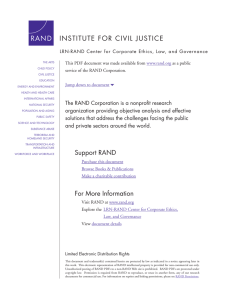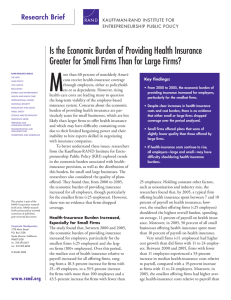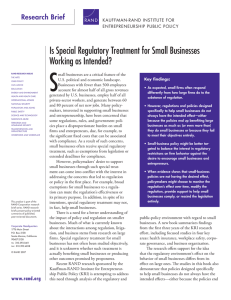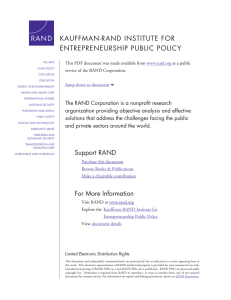T Investment Advisers and Broker-Dealers Research Brief
advertisement
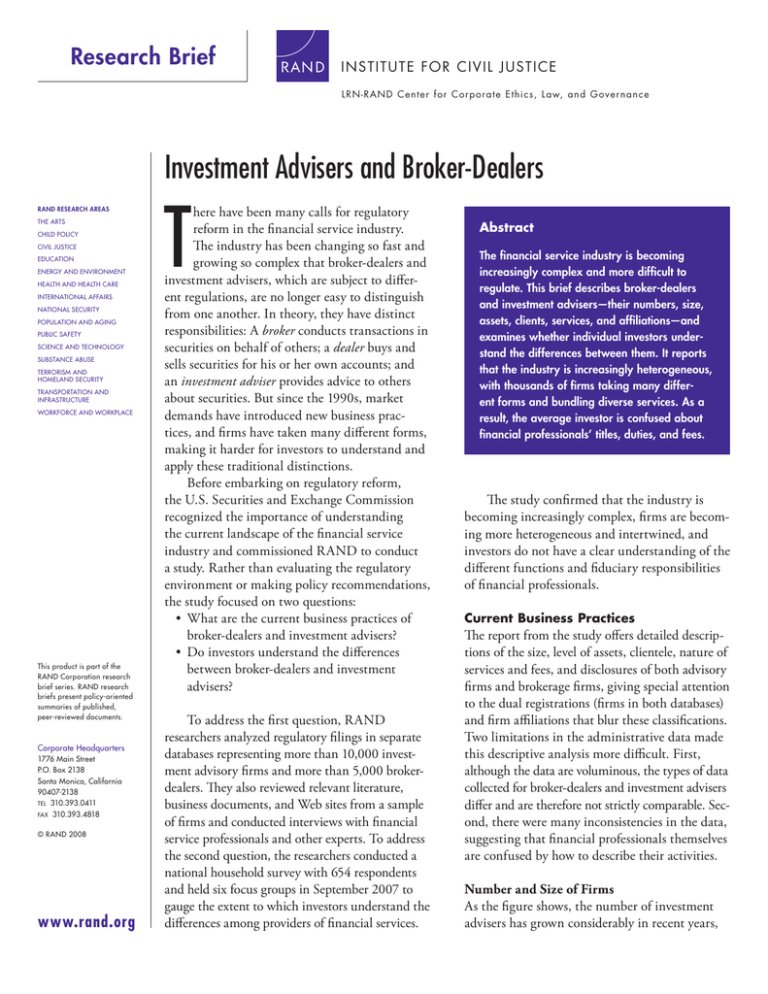
Research Brief IN S TITUTE F O R C IV IL JUS TIC E LRN-RAND Center for Corporate Ethics, Law, and Gover nance Investment Advisers and Broker-Dealers RAND RESEARCH AREAS THE ARTS CHILD POLICY CIVIL JUSTICE EDUCATION ENERGY AND ENVIRONMENT HEALTH AND HEALTH CARE INTERNATIONAL AFFAIRS NATIONAL SECURITY POPULATION AND AGING PUBLIC SAFETY SCIENCE AND TECHNOLOGY SUBSTANCE ABUSE TERRORISM AND HOMELAND SECURITY TRANSPORTATION AND INFRASTRUCTURE WORKFORCE AND WORKPLACE This product is part of the RAND Corporation research brief series. RAND research briefs present policy-oriented summaries of published, peer-reviewed documents. Corporate Headquarters 1776 Main Street P.O. Box 2138 Santa Monica, California 90407-2138 TEL 310.393.0411 FAX 310.393.4818 © RAND 2008 www.rand.org T here have been many calls for regulatory reform in the financial service industry. The industry has been changing so fast and growing so complex that broker-dealers and investment advisers, which are subject to different regulations, are no longer easy to distinguish from one another. In theory, they have distinct responsibilities: A broker conducts transactions in securities on behalf of others; a dealer buys and sells securities for his or her own accounts; and an investment adviser provides advice to others about securities. But since the 1990s, market demands have introduced new business practices, and firms have taken many different forms, making it harder for investors to understand and apply these traditional distinctions. Before embarking on regulatory reform, the U.S. Securities and Exchange Commission recognized the importance of understanding the current landscape of the financial service industry and commissioned RAND to conduct a study. Rather than evaluating the regulatory environment or making policy recommendations, the study focused on two questions: • What are the current business practices of broker-dealers and investment advisers? • Do investors understand the differences between broker-dealers and investment advisers? To address the first question, RAND researchers analyzed regulatory filings in separate databases representing more than 10,000 investment advisory firms and more than 5,000 brokerdealers. They also reviewed relevant literature, business documents, and Web sites from a sample of firms and conducted interviews with financial service professionals and other experts. To address the second question, the researchers conducted a national household survey with 654 respondents and held six focus groups in September 2007 to gauge the extent to which investors understand the differences among providers of financial services. Abstract The financial service industry is becoming increasingly complex and more difficult to regulate. This brief describes broker-dealers and investment advisers—their numbers, size, assets, clients, services, and affiliations—and examines whether individual investors understand the differences between them. It reports that the industry is increasingly heterogeneous, with thousands of firms taking many different forms and bundling diverse services. As a result, the average investor is confused about financial professionals’ titles, duties, and fees. The study confirmed that the industry is becoming increasingly complex, firms are becoming more heterogeneous and intertwined, and investors do not have a clear understanding of the different functions and fiduciary responsibilities of financial professionals. Current Business Practices The report from the study offers detailed descriptions of the size, level of assets, clientele, nature of services and fees, and disclosures of both advisory firms and brokerage firms, giving special attention to the dual registrations (firms in both databases) and firm affiliations that blur these classifications. Two limitations in the administrative data made this descriptive analysis more difficult. First, although the data are voluminous, the types of data collected for broker-dealers and investment advisers differ and are therefore not strictly comparable. Second, there were many inconsistencies in the data, suggesting that financial professionals themselves are confused by how to describe their activities. Number and Size of Firms As the figure shows, the number of investment advisers has grown considerably in recent years, while the number of broker-dealers has slightly declined. The number of dual registrants remained about the same. Most investment advisory firms are small: More than half reported having no more than 10 employees. Only about one-fourth of these firms reported having more than 50 employees, and less than 8 percent reported more than 100 employees. However, 69 investment advisory firms with individual clients reported that they employed more than 1,000 individuals each. Broker-dealers do not report on employment or clientele but offer extensive information on finances. A defining attribute of a broker-dealer is whether it clears or carries customer accounts. Those firms that do so constitute only about 10 percent of registered broker-dealers but tend to be much larger than other firms. Their mean reported assets and ownership equity is $10 billion (with a median of $250 million), compared to a mean of $25 million (and a median of $7 million) for brokerages that have no such accounts. Broker-Dealers, Investment Advisers, and Dually Registered Firms (2001–2006) Dual Activity and Affiliations Most of the 15,000 firms analyzed reported being engaged strictly as an investment adviser or as a broker-dealer without any affiliations with those that provide the complementary service. The number of dually registered firms ranged between 500 and 550 from 2001 to 2006, but they grew substantially in terms of mean reported revenues, expenses, and net incomes over that period. As firms grow larger, the study found, they tend to engage in a fuller range of services, often by affiliating with other firms. More than one out of every five investment advisers, for example, reported that a related person was a broker-dealer, municipal-securities dealer, or governmentsecurities broker or dealer. Among broker-dealers, about 40 percent either directly or indirectly control, are controlled by, or are under common control with a firm engaged in the securities or investment advisory business. In many cases, the researchers could not disentangle the services and business relationships of firms that were dually registered or affiliated with other firms. Some corporations appeared to have multiple subsidiaries or business units, each registered separately as an investment adviser or brokerdealer, although the data did not identify these relationships. In some cases, the researchers could classify firms only by piecing together evidence based on multiple sources of information, such as regulatory filings, business documents, Web sites, and firm interviews. In some cases, even these efforts were not sufficient to classify the firms. Firms (thousands) 10 Total broker-dealers Total investment advisers 8 6 4 2 0 Dual Dual 2001 2002 Dual Dual 2003 2004 Year Dual Dual 2005 2006 SOURCES: Broker-dealer data are from Financial and Operational Combined Uniform Single reports. Investment adviser data are from Investment Adviser Registration Depository. NOTE: Dual indicates firms listed in both databases. Investor Understanding Given such complexity, it is not surprising that typical investors are confused about the nature of the services offered by their financial professionals. Many of those surveyed, as well as focus-group participants, did not understand the key distinctions between investment advisers and broker-dealers: their duties, the titles they use, the services they offer, or the fees they charge. They attributed part of their confusion to the dozens of titles used in the field, including generic titles, such as financial advisor and financial consultant, as well as advertisements that claim, “We do it all.” Despite their confusion, however, most study participants expressed satisfaction with their own financial professionals, with whom they tended to have long-term relationships. The characteristics they identified as most important to them were attentiveness to their needs, accessibility, and trustworthiness. ■ This research brief describes work done for the LRN-RAND Center for Corporate Ethics, Law, and Governance within the RAND Institute for Civil Justice, documented in Investor and Industry Perspectives on Investment Advisers and Broker-Dealers, by Angela A. Hung, Noreen Clancy, Jeff Dominitz, Eric Talley, Claude Berrebi, and Farrukh Suvankulov, TR-556-USSEC (available at http://www. rand.org/pubs/technical_reports/TR556/), 2008, 228 pp., $48, ISBN: 978-0-8330-4403-7. The RAND Corporation is a nonprofit research organization providing objective analysis and effective solutions that address the challenges facing the public and private sectors around the world. RAND’s publications do not necessarily reflect the opinions of its research clients and sponsors. R® is a registered trademark. RAND Offices Santa Monica, CA • Washington, DC • Pittsburgh, PA • Jackson, MS / New Orleans, LA • Cambridge, UK • Doha, QA RB-9337-USSEC (2008) I N S T I T U T E FOR C I V I L JU S T I C E LRN-RAND Center for Corporate Ethics, Law, and Gover n a n c e THE ARTS CHILD POLICY This PDF document was made available from www.rand.org as a public service of the RAND Corporation. CIVIL JUSTICE EDUCATION ENERGY AND ENVIRONMENT HEALTH AND HEALTH CARE INTERNATIONAL AFFAIRS NATIONAL SECURITY This product is part of the RAND Corporation research brief series. RAND research briefs present policy-oriented summaries of individual published, peerreviewed documents or of a body of published work. POPULATION AND AGING PUBLIC SAFETY SCIENCE AND TECHNOLOGY SUBSTANCE ABUSE TERRORISM AND HOMELAND SECURITY TRANSPORTATION AND INFRASTRUCTURE The RAND Corporation is a nonprofit research organization providing objective analysis and effective solutions that address the challenges facing the public and private sectors around the world. WORKFORCE AND WORKPLACE Support RAND Browse Books & Publications Make a charitable contribution For More Information Visit RAND at www.rand.org Explore theLRN-RAND Center for Corporate Ethics, Law, and Governance View document details Limited Electronic Distribution Rights This document and trademark(s) contained herein are protected by law as indicated in a notice appearing later in this work. This electronic representation of RAND intellectual property is provided for non-commercial use only. Unauthorized posting of RAND PDFs to a non-RAND Web site is prohibited. RAND PDFs are protected under copyright law. Permission is required from RAND to reproduce, or reuse in another form, any of our research documents for commercial use. For information on reprint and linking permissions, please see RAND Permissions.





